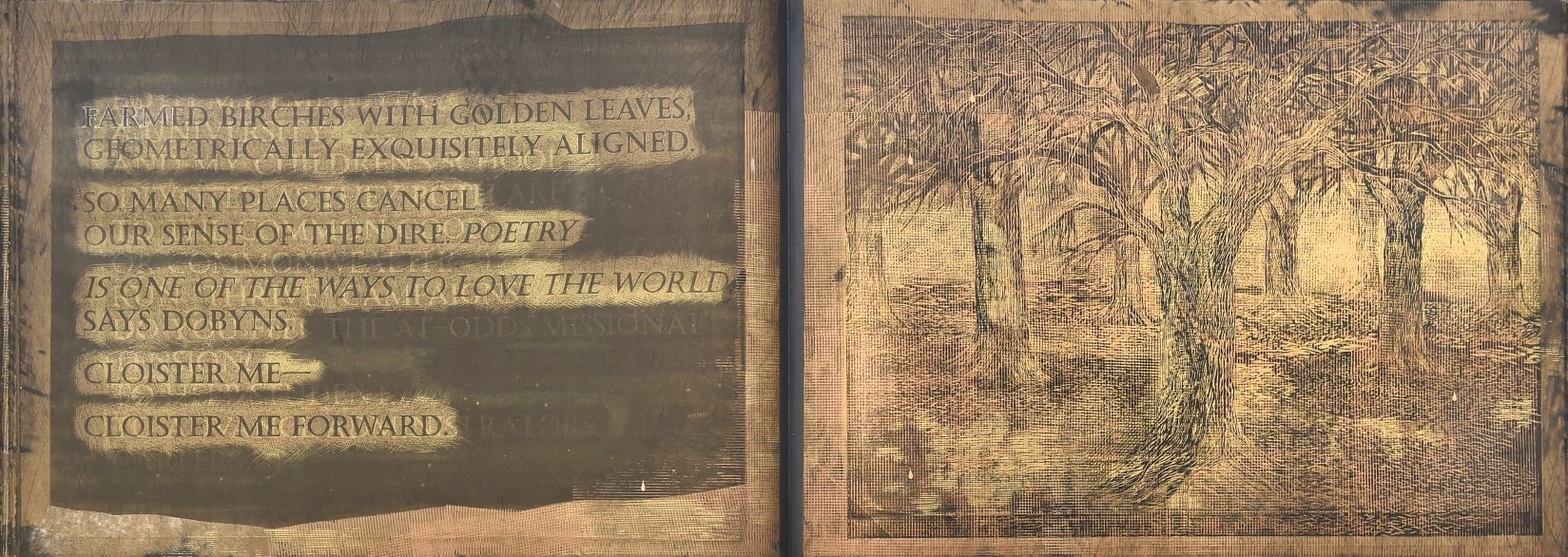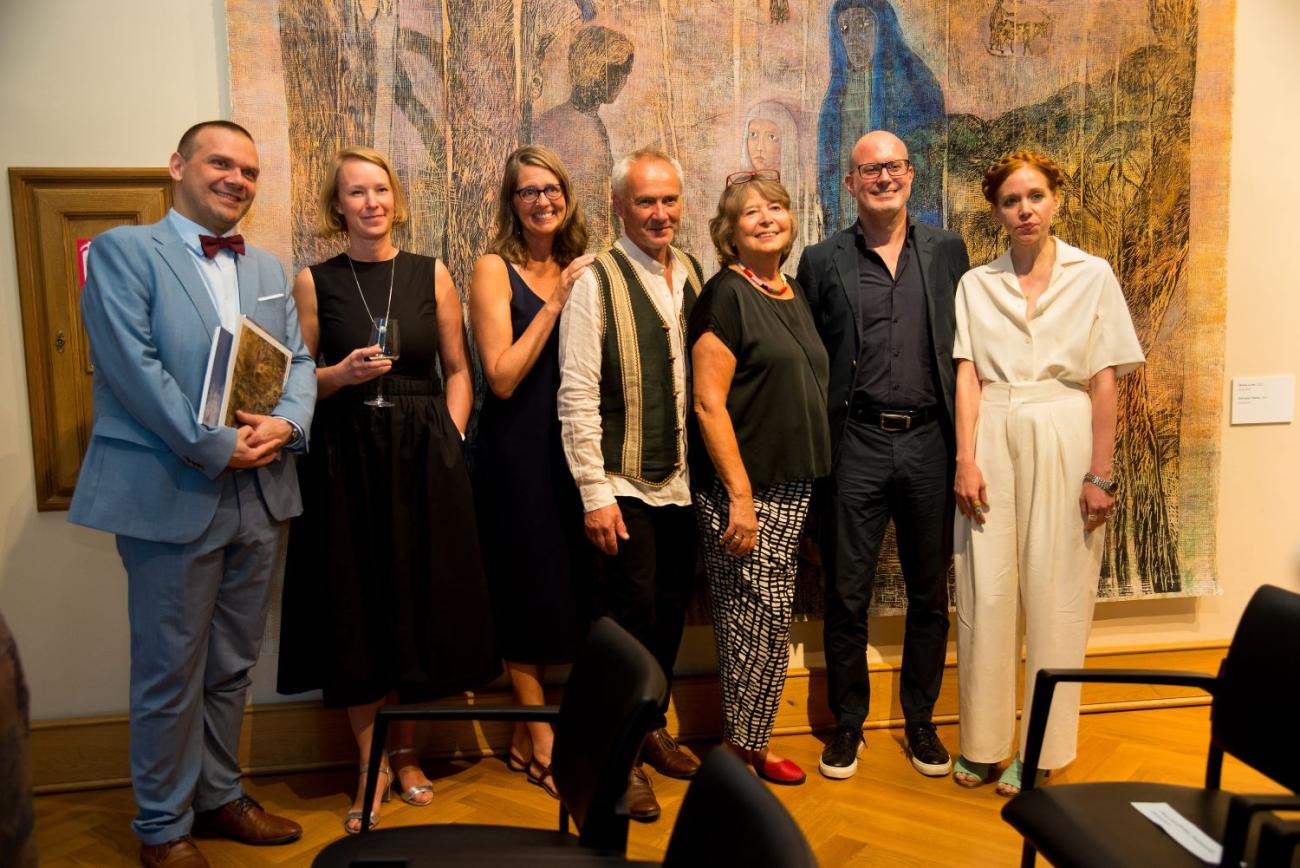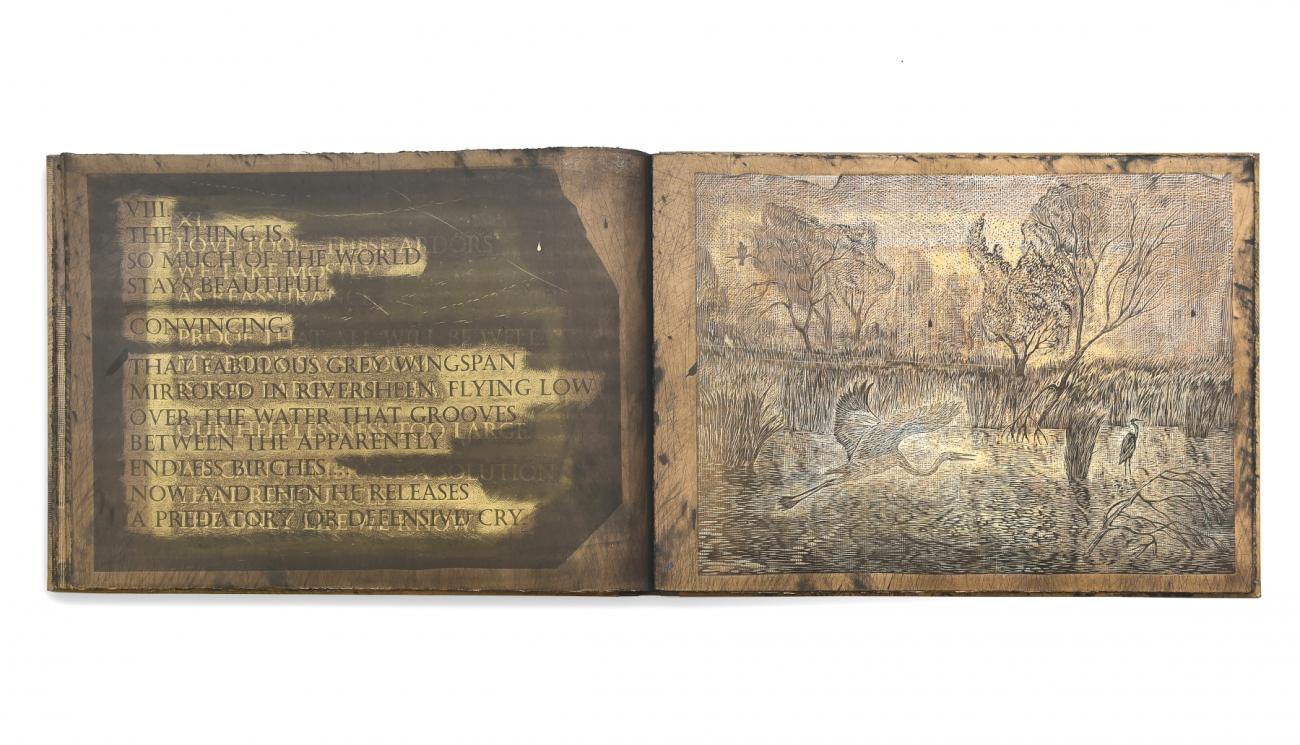Holding to hope
In July of 2022, Professor of English Sally Ball traveled to Prague, Czech Republic for a ceremony marking the opening of an art exhibition featuring her work. Organized in recognition of the 2022 Czech presidency of the Council of the European Union, the event was a glittering, heady affair at the Museum of Decorative Arts—attended by arts luminaries and eminent government officials.
Also in July of 2022, an unprecedented heat wave rolled across Europe, killing thousands, mostly in Spain and Portugal. Wildfires ravaged parts of France, the U.K., Greece and the U.S. Heavy rains caused floods across large areas of Iran and Pakistan. And the migratory monarch butterfly was added to the endangered species list.
These are the kinds of everyday, cataclysmic events that Ball chronicles in “Hold,” the subject of the Prague exhibit. The 2018 work, a limited edition, large-form artist’s book of Ball’s text and linocut prints by artist Jan Vičar, was the subject of the Czech exhibition. Some of Ball’s poetry from the book also appeared in her separate collection, “Hold Sway,” published in 2019.
‘So much of the world stays beautiful.’
Ball’s words on a page opposite a linocut of a heron in flight communicate the essence of the “Hold.” The extraordinary, “convincing,” beauty of things in nature—like the heron, who appears several times throughout the book in text and image—is enough to lull us into climate complacency. How easy it is to forget that we’ve polluted, consumed, and decimated much of the earth, when we’re gazing upon a miraculous creature like the heron, or a snail, or farmed birches.
While news of the world in 2023 is grimmer than ever, we spoke with Ball about continuing to make things of beauty and what we can do to hold onto hope.
Question: You’ve talked elsewhere about the environment that was the inspiration for some of this poetry: a residency in France in a pastoral setting—with a view of a nearby industrial area as your “anti-muse.” Do you find that your work is often informed by that sort of juxtaposition?
Answer: Yes—it was this medieval village of 250 people in the midst of farms (cows, birch trees, Roman bestiary frescoes that had been discovered under whitewash on the ceiling of the church…) and then the nuclear plant in view when you walked around the bend of the river… and yes, I think much of art is sparked at such juxtapositions—mine and others’! The simultaneity of seeing the past and the present, the handcrafted and the super-industrial: the “natural” and the “scientific”—you get this yo-yo apprehension: These things are SO DIFFERENT, no, these things are THE SAME—and all sorts of synapses start to fire.
Q: Is there a way to reconcile the dichotomy in your work—parts of the world remaining beautiful even during its destruction—in artwork? Can the destruction be mitigated? Is it enough to draw attention?
A: Well, the book that partly inspired the poem was Roy Scranton’s “Learning to Die in the Anthropocene”—a book I have regularly misremembered the title of as “Learning to *Live* in the Anthropocene”—in which Scranton argues that we can’t mitigate or stop the destruction, but maybe we can learn to perceive it, and take responsibility for it, gracefully. I suppose my inclination to change the title reveals a . . . refusal of (or incapacity for) anti-hope? Which is different from blithe confidence. And this question about the value of attention: I believe it’s crucial to pay it, and then maybe also (but less so) useful to draw it. Attention itself is both the nectar of life (I mean: the source of deepest pleasures, the most discerning insights, etc…) and—increasingly—transactional, commodified (clicks and likes). I think art increases something we might call “the habitation of consciousness,” and I continue to believe that’s good. I’m in favor of more thinking, less autopilot?!?!
Q: Was it difficult to transition to another project after completing "Hold" and "Hold Sway," owing to the sheer depth (and scope) of the works? How did COVID impact that?
A: Poetry and art are so slow: I was always also doing other work, I think. "Hold" has had the longest life of anything I’ve written (new exhibits, acquisitions, etc., in Prague for EU events last summer, others, ongoing still…). And also: “Hold” is so in keeping with the way I work: reading, looking at the world, thinking, trying to get closer and closer to understanding. Sometimes wry, built of experiences from across at least the last ten years… so it doesn’t seem separate in a way that could be left behind?
During the pandemic, it seemed possible I’d never see the book again! And that it might have missed its chance. But when Paris reopened, the Academy of Fine Arts there celebrated with an exhibition of Jan’s other work and the book, and I was able go—through a completely empty Charles de Gaulle Airport, amazing, amazing. I mean: There was exactly one other person at customs! The events were incredibly moving: people were so glad to be together, so alert to both risk and —love! Common needs and hopes. Then we were able to have an event at ASU last spring (and now ASU Distinctive Collections owns a copy! So anyone can visit it!)
Q: Does your current work or project have any relation to the poetry in 'Hold' or 'Hold Sway'?
A: Probably yes but hard to answer, jinxy, maybe!
Q: You teach an ASU class about writing and arts collaboration. Besides that, do you have more plans for collaborations, either with Jan Vičar or another artist or writer?
A: I have a suspended but beloved project in process with St. Louis photographer Michael Eastman, which I know I will return to with excitement. Some of that work appeared in The Common. And last spring I team-taught that collaboration class with the wonderful smart Julie Anand from the School of Art, and we are in the midst of getting to know each other’s work and process(es) and moving toward a full collaboration together over the coming year. The first “test” pieces will be part of our class’s exhibit of their project, “Echoes Seen: Collaborations of Image & Verse”—opening reception Sep. 15 at Step Gallery downtown!
Image 1: From the July 2022 art exhibition: Czech Minister of Culture Martin Baxa; Curator at the Czech Museum of Modern Art Barbora Kundračíková; Sally Ball; Jan Vičar; Director of the Museum of Decorative Arts Helena Koenigsmarková; Patrick Maffei of Ditesheim & Maffei Fine Art in Neuchatel, Switzerland; and Becka McFadden, performance artist. Photo credit Museum of Decorative Arts, Prague.
Image 2: A page from "Hold" showing the heron opposite the words, "So much of the world stays beautiful." Photo courtesy Sally Ball. See more images from the book on Ball's website.


